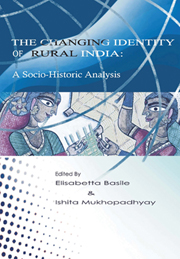Book contents
- Frontmatter
- Contents
- Acronyms and Abbreviations
- About the Authors
- INTRODUCTION
- PART 1 INDIAN RURAL TRANSFORMATIONS
- PART 2 INEQUALITY IN RURAL INDIA
- Social Capital and Poverty Reduction Strategies: The Case of Rural India
- An Overview of Indian Microfinance
- Income-based Estimates vs Consumption-based Estimates of Poverty: Evidence from Rural Tamil Nadu after Liberalization
- Occupational Diversification of the Rural Workers: Some Results from Field Surveys in West Bengal
- Literacy and Externalities in Human Development
- PART 3 SOCIAL MOVEMENTS AND IDENTITIES
- Appendix 1 Socio-Economic Indicators of Rural India
Literacy and Externalities in Human Development
from PART 2 - INEQUALITY IN RURAL INDIA
Published online by Cambridge University Press: 05 March 2012
- Frontmatter
- Contents
- Acronyms and Abbreviations
- About the Authors
- INTRODUCTION
- PART 1 INDIAN RURAL TRANSFORMATIONS
- PART 2 INEQUALITY IN RURAL INDIA
- Social Capital and Poverty Reduction Strategies: The Case of Rural India
- An Overview of Indian Microfinance
- Income-based Estimates vs Consumption-based Estimates of Poverty: Evidence from Rural Tamil Nadu after Liberalization
- Occupational Diversification of the Rural Workers: Some Results from Field Surveys in West Bengal
- Literacy and Externalities in Human Development
- PART 3 SOCIAL MOVEMENTS AND IDENTITIES
- Appendix 1 Socio-Economic Indicators of Rural India
Summary
INTRODUCTION
Education and health are the two important social variables that expand the human capital base of an individual, thereby enabling an individual to make better use of economic opportunities. These variables also foster the capacity of an individual to enhance the freedom of enjoying better quality of life. Thus education contributes to economic growth via human capital formation and it also leads to expansion of freedom through human development (Dreze and Sen, 2002).
Bowman (1992) opines that apart from enriching economic growth and making the individuals better producers, there are also other contributions of human capital. These other aspects are referred to as ‘externalities of human capital’. Included in these externalities are the operative forces, transmitting knowledge across generations. It evinces in particular some external benefits of education among women. Education enables a woman to (a) acquire the ability to manage her own household, given the budget constraint and also to ensure that the family's nutritional standards and hygiene is maintained and (b) contribute to the quality of learning in succeeding generations (Schultz, 1995; p. 546).
In sum, returns from education can be classified in terms of economic returns and social returns (referred to as the ‘externalities of education’). ‘Externality’ in conventional economics refers to those actions of a set of economic agents that could have either positive or negative effects on other set of economic agents. The market is inoperative to such actions corresponding to appropriate prices and hence they are external to the market forces.
- Type
- Chapter
- Information
- The Changing Identity of Rural IndiaA Sociohistoric Analysis, pp. 174 - 196Publisher: Anthem PressPrint publication year: 2009

